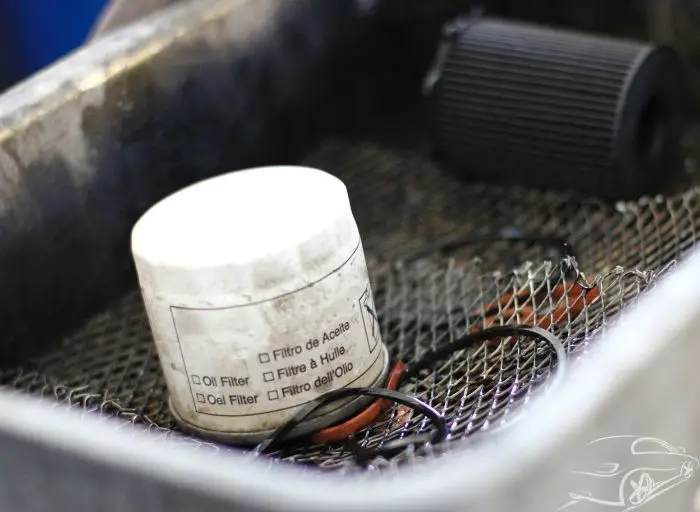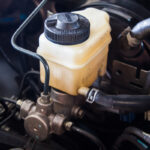
If you’re dreading the thought of changing your oil filter because you’ve heard horror stories about it being too difficult, don’t worry. We’ll show you all the easy steps to take to make sure your car is running smoothly for years after.
To help prevent any problems with your vehicle, there are a few signs of bad oil filters that you should be aware of. Changing your oil filter when in need is crucial to protect the engine.
Oil filter is rated by the amount of time it can effectively filter oil. A bad oil filter means the real contamination and debris is still suspended in your engine and you could run into issues. Operating with a clogged oil filter can cause some serious problems such as :
- Engine Damage: Every time the engine runs, the oil is forced to filter through the dirty oil filter. This can cause engine damage as it is filled with debris and contaminants.
- Increased Oil Consumption: As the engine is filled with contaminants and debris, the oil becomes dirty faster and you will need to change it more frequently.
- Restricted Engine Air Flow: Oil that is filled with contaminants and debris can clog up airflow and restrict the movement of air to vital components like your radiator.
Table of Contents
5 Not So Obvious Signs of Bad Oil Filter
#1 Dirty Exhaust Fumes
If you see dark smoke coming out of your exhaust pipe, the chance is that your oil is contaminated with debris and contaminants. The oil filter isn’t filtering the particles out anymore, so the engine has to work harder to circulate the dirty oil. But it can be cleaned by an effective oil filter.
Once this happens, you’ll get a burning odor inside your car too.
#2 Noticeable Engine Vibration
If you notice that your car engine is vibrating more than usual, it’s probably because your filter is clogged up with debris and contaminants. This occurs because the engine has to work harder to circulate the dirty oil and clean it. As a result, you might experience some engine noise and vibrations.
#3 Engine Starts To Overheat
This is relatively rare during cold weather, but if you notice your car is overheating or boiling over when idling in traffic, the chances are there’s a problem with the cooling system like a leaking head gasket or a cracked radiator. This needs to be fixed as soon as possible before it damages your engine.
Moreover, the engine needs lubricants to cool it off, once the oil filter is in bad condition, the engine doesn’t get enough liquid to cool itself.
You can see the Engine Light on when it’s overheated and it’s time to check it.
#4 Noise from the Engine
There are many metallic parts in the engine and they can work well together due to lubrication. However, if there aren’t enough of it, you can hear the parts grinding against each other. In addition, this also causes the engine to overheat.
#5 Low Oil Pressure
If you notice, in normal conditions, your oil pressure gauge stays at a consistent pressure. However, if one day it drops significantly to a low level, it’s because there is a problem with your oil filter. You need to check your oil immediately and there’re 2 possible reasons for this:
- Clogged oil filter leading to low oil pressure
- You have a problem with the oil pump
How to Replace Your Oil Filter
The most important thing to remember is that you have to change your oil filter every 3,000 miles or 3 months. You also have to take it out of your car before you do anything else, so check out our step-by-step guide below on how to change your oil filter.
#1 Check for Damage
Before you begin any project or task, it’s important to check the vehicle for any damage. If the unit has been crashed and is rusted, you will need to replace parts such as breaks, wheel bearings, and possibly even suspension. Using a few drops of oil with a rag can help if your oil filter has been destroyed by metal shards.
Then, place the rag around the hole and start slowly dropping oil down until it runs out of the filter and into a container underneath.
#2 Take Out the Old Filter
Different vehicles can have different locations for their oil filter. You will need to take a look at your owner’s manual and follow the instructions. It will be somewhere under the car (possibly near the engine) and you might need a set of tools to help you remove it (like wrenches, oil filter wrench, and jack)
Once you’ve removed it, take out the old filter and throw it away in a trash can that is covered or sealed off from animals or children.
Tips for Changing Oil Filters By Yourself
1. Prepare to Get Dirty
It is important that all the parts including the oil filter are clean before you begin any project. If it’s not, then you might end up contaminating yourself with dirty items. This also prevents any bug or dirt from entering your vehicle.
2. Get the Right Tools
This is a very easy job to do. You won’t need any power tools to do this, you only need the right hand tools. That tool is your ratchet set. So it’s best if you have all your tools ready before starting off the job. Then it makes it easier for you to get the job done smoothly and fast.
Oil Filter Replacement Cost
The cost of oil filter replacement is very much affordable for car owners. The filter itself costs from $10 to $20. The labor cost to replace one depends on where you live. If you are in NYC, it will be much higher than in other states like Texas or Ohio.
However, this task is very simple and you can DIY to save you some money. It could be costly if you don’t perform the job at the right time.
Final Words
If you don’t change your oil filter regularly, the engine will get damaged. You can even realize that you have been driving around with a clogged filter for days with the obvious signs mentioned above. The engine in the car won’t function properly if it does not get lubricants in it to cool itself. You can do this yourself and save some money, plus your vehicle will run much better than before when you do this.
Hi there! I’m Naomi O’Colman. I’ve got years of experience working at an auto repair shop here in Texas under my belt. On top of that, ever since I was a kid I’ve been passionate about the auto industry. Since I’ve joined the team at automotivegearz.com I’ve been enthusiastically sharing my passion and insights with my readers. I’m dedicated to delivering high quality content and helping you stay up to date with the latest automotive trends and products out there!







